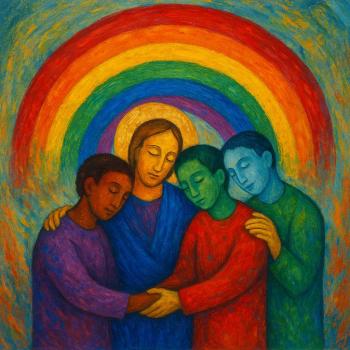We are social creatures. We thrive when we are in community and community is one of the events that makes us human. Community challenges us to grow spiritually, physically, emotionally and mentally. This week, I want to explore John Wesley’s ordinance of God that focuses on public worship and reflect on Dietrich Bonhoeffer’s book, “Life Together”. I want to demonstrate why public worship and public gatherings of engagement for faith and intellectual development is crucial for our own personal growth, but also for the growth of communities.
In the last several years, we have heard more and more about the loneliness and meaning crisis. In one report last week from the United Kingdom, it was reported that young people are now gravitating towards authoritarian or even willing to have a dictator governing them partially as a response to these crises. This growing trend towards authoritarianism is alarming and speaks volumes about the deep-seated yearning for community and belonging that is being left unaddressed. For many, the church has historically been a sanctuary where this need for connection, purpose, and support is met. In re-examining John Wesley’s ordinance of God alongside Bonhoeffer’s reflections, we can see that public worship and gatherings are more than just rituals; they are vital lifelines in the face of growing societal fragmentation. These sacred spaces foster relationships, nurture our spirits, and provide a framework within which we can engage intellectually and emotionally. As such, the church remains an indispensable pillar in a world increasingly marked by solitude and disillusionment.
18 Years Old
A client last week inquired about my experiences with contemplation and mindfulness. I briefly gave him my “call story”. I spent two years from age 18 to 20 considering joining a monastic community and living alongside an intentional community as I was discerning my call to professional ministry in the Catholic church.
My formation director instructed me while I was in college considering our undergraduate seminary to go to morning chapel daily, arriving an hour early to pray the rosary. I was to go to afternoon chapel and say compline before bed. I was to take meals with the seminarians and was invited to various events at the seminary. Here, I learned to pray in a contemplative manner, learned more about the Catholic faith beyond what I knew growing up. I also had an undeclared minor in Catholic theology.
This would all change in 1998 when I met my now wife. Offering me leftover tacos and being a pretty red head, I left my plans to join the monastery and created a life with her. While I never joined the Benedictines formally as a monastic, I would later join as an oblate first with St. Vincent’s in Latrobe, Pa and later with Mount Saint Benedict in Erie, Pa.
According to the Mount Saint Benedict website,
“Relationships are at the heart of a Benedictine spirituality: one’s relationship with God, with others, and with all of creation. Benedictines believe that the community – a monastery, a family, a parish, etc. – is where we meet God and discover the fullness of life. It is the laboratory wherein we learn to grow into the loving person God calls us to be. The community is where we pray together, listen to one another, and serve each other as needed. These elements of prayer, listening, and service form the monastic heart.”
My two years with St. Mark’s and overall, my four years at Gannon University taught me a lot about living in an intentional community. I was very involved in our campus ministry program, having meals together every Tuesday night and going on several immersion trips throughout my four years. These moments would shape me spiritually, emotionally and mentally and create the middle-aged contemplative I have become today.
John Wesley on the Church
In his sermon, “On the Church” emphasized that the church is not just a building, but rather a body of people united in the service of God. Reflecting on the Epistle of Paul, Paul’s letter to the Ephesians, Wesley centers in on the theme of unity. Here, Paul and then Wesley points to the unity of the Church, grounded in “one Spirit,” “one hope,” “one Lord,” “one faith,” “one baptism,” and “one God and Father of all.” He explains how the true church is a body of believers that are unified by the holy spirit.
While this sermon illustrates the division between the church as building and church as the people of God, it does not give us insight as to what life together would look like. For this, we turn to Dietrich Bonhoeffer.
“Life Together”
To get an idea on how to do community, let us turn to Dietrich Bonhoeffer’s book, “Life Together”. Written during a time of intense persecution under the Nazi regime, the book reflects on the essential nature of communal Christian life and its importance in a world torn apart, one marked by isolation and individualism. It is felt that the parallels to 2025 are profound and are much needed word in a world of loneliness and meaninglessness.
Community, Scripture, grace, dangers of idealization, grace, solitude and community and daily practice all play central themes in the book.
For Bonhoeffer, community is not something we create but a gift from God. It is a divine reality into which we are called. He argues that true Christian community is grounded in Christ and his Word. Scripture then is the foundation of the community that provides genuine fellowship and mutual encouragement. When I am doing couples or family work, I often talk about the necessity of mutuality. He stresses the importance of shared Bible study, prayer, and meditation.
Much like my early experiences with the seminary and monastery, Bonhoeffer outlines practical aspects of communal life, including:
- Morning and Evening Devotions: Shared times of prayer and scripture reading.
- Table Fellowship: Sharing meals as a symbol of unity and fellowship.
- Mutual Service: Serving one another in humility and love.
- Confession and Forgiveness: Practicing honest confession and offering forgiveness as a means of healing and restoration.
Pop culture will romantize monastery life whether it is in Asian/Indic practice or Abrahamic tradition. The reality cannot be farther from the truth. Often you are in community with some people you like, many that may get on your nerves. In my tradition, prayer and work or ora et labora are central themes to the work that we are taught. Going to mass throughout the day and praying all the time, living a structured life can be stifling and looking back, I realize that maybe that was not the life for me.
Bonhoeffer cautions against romanticizing or idealizing community. He acknowledges that conflict and imperfection are inevitable. He warns against the danger of confusing human desire for a perfect community with the real, messy, and grace-filled community that God provides.
The other aspect that is often overlooked are notion of solitude and community. We may think that the two cannot coexist, but Bonhoeffer explores the relationship between solitude and community. He argues that both are essential for spiritual growth. Solitude allows us to deepen our relationship with God, while community provides the context for expressing and living out our faith.
Finally, the book is permeated with the idea of God’s grace. That it is only through God’s grace that true community can exist. Grace is a hallmark of my Wesleyan tradition, and I could not agree more.
In Closing
I am a bit old school. I still think the church is a solid institution for not only personal and spiritual growth but also for community growth spiritual enrichment. The Church has lost its way over the last 50 years. Bad theology, magnetic but abusive personalities and the hyprocrisy that Jesus warned us about when he called the church leaders “whitewashed tombs” have turned many away. I envision a church where anyone is welcome, one that is open to all the dangerous questions and does not have a right answer to any of them. A church where all sinners feel welcome. We need less nones and more somes.













